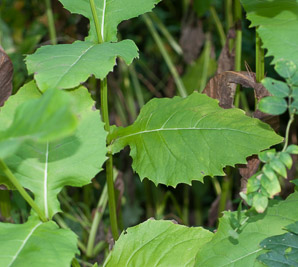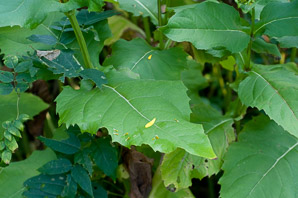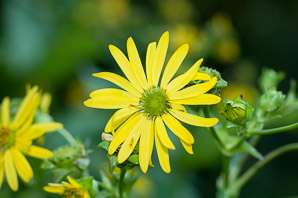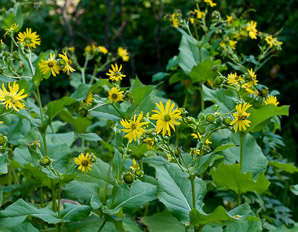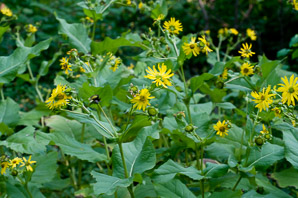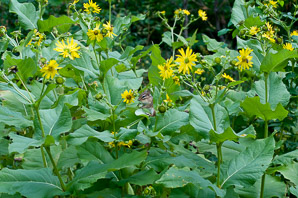
|
Silphium perfoliatum L. Cup plant, Indian cup, ragged cup, carpenter weed
Cup plant, named for the cup-shaped depression formed where opposing leaves meet the stem, is another member of the very large aster family. It is a North American native. Identification: Plants are 4-10′ (1.2-3 m) tall, on single stalks that branch only near the flowering top. They could be mistaken for a type of sunflower, except for the unusual leaves. The stem is thick and hairless, four-sided, and green or purple. Leaves are opposite, joined to each other at the stems, producing a depression between them that holds water. The trapped water often attracts birds. Leaves are rough to the touch, and coarsely toothed. Flowers have a dark yellow central disk surrounded by 18-40 bright yellow petals ("ray florets"). They appear from July to October. Fruits are egg-shaped achenes ¼-½″ (7.6-12 mm) long, with wings. From Britton, Nathaniel Lord, and Brown, Addison, An illustrated flora of the northern United States, Canada and the British Possessions, 1913; scanned by the Natural Resources Conservation Service. Online References:
The University of Wisconsin's Robert W. Freckmann Herbarium The Lady Bird Johnson Wildflower Center Kansas Wildflowers and Grasses The USDA Plants Database (PDF) 8/19/2010 · Nod Rd., Groton, Massachusetts · ≈ 2 × 1′ (62 × 41 cm) 8/19/2010 · Nod Rd., Groton, Massachusetts · ≈ 17 × 12″ (44 × 29 cm)
Silphium perfoliatum description by Thomas H. Kent, last updated 25 May 2020. © FloraFinder.org. All rights reserved. |
8/19/2010 · Nod Rd., Groton, Massachusetts · ≈ 8 × 5″ (19 × 13 cm) 8/19/2010 · Nod Rd., Groton, Massachusetts · ≈ 8 × 5″ (19 × 13 cm) 8/19/2010 · Nod Rd., Groton, Massachusetts · ≈ 2 × 1′ (62 × 41 cm) 8/19/2010 · Nod Rd., Groton, Massachusetts · ≈ 2 × 1′ (62 × 41 cm) 8/19/2010 · Nod Rd., Groton, Massachusetts Range: Zones 3-9:
|


